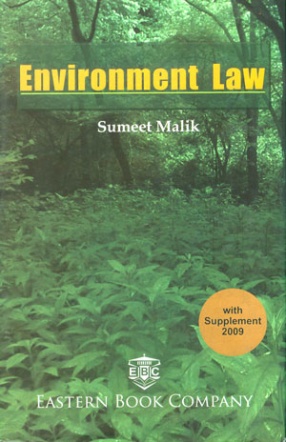
Volume 4/2
Luke Lazarus Arnold
Deforestation in Decentralised Indonesia: What's Law Got to Do with it?
A growing number of studies point to significant changes in the dynamics of deforestation in Indonesia since the introduction of decentralised governance in 2001. This essay argues that law plays an important and underestimated role in facilitating these new dynamics. This role is not limited to mere implementation failures; many of the ways in which Indonesian law makes deforestation possible can be traced back to the content of the laws themselves. In order to demonstrate this point, the essay first examines the context in which Indonesia’s forestry and decentralisation laws were formulated and the salient provisions of these laws. This is followed by a discussion of the dynamics of deforestation since decentralisation and an analysis of five key ways in which law is partly responsible for the current situation: a flawed division of authority between the Central Government and the regions’; inconsistent, ambiguous and “hollow” legislation; legislatively entrenched departmentalism; the marginalisation of forest communities; and a lack of legislative support for public participation, public interest litigation and other processes to promote sustainable forest management.
Hugo Tremblay
The Legal Framework for Groundwater Allocation in Quebec: Towards Integrated Water Management
This paper aims at providing a model of the legal framework for groundwater allocation in the province of Quebec (Canada), identifying its potential deficiencies and suggesting possible improvements. In Quebec, groundwater is a res communis. The right to use it is tied to real estate property. This right forms the basis of the legal framework for the management of groundwater quantity. However, according to statutory law, the actual use of groundwater also depends on governmental authorisations that limit quantities used. The main statutory instrument for managing the resource is the Groundwater Catchment Regulation (GWCR), which aims at conflict prevention between first users and new users by means of governmental authorisations. In agricultural areas, an additional authorisation regime indirectly prioritises agricultural groundwater uses. Finally, legal mechanisms addressing conflicts between water users rely on the general litigation framework provided by Quebec law without establishing an order of priority for the different uses of the resource. According to Integrated Water Resources Management, four aspects of the legal framework for groundwater quantity management can be modified to increase the efficiency of the allocation regime: 1) provisions should be made to preserve a residual environmental flow; 2) an order of priority should be established between the different uses to minimise conflict; 3) the scope of the regime should be extended to all groundwater users to increase its efficiency; 4) stakeholders should participate in the management of the resource.
Comments
The European Commission 2008 Directive Proposal on Biofuels
by Florent Pelsy
This article focuses on the 2008 Directive Proposal of the European Commission on biofuels. The development of biofuels as a renewable energy source has been perceived as a priority by the European Union. Indeed biofuels are approached by the EU as a new ‘win-win’ solution that could both reduce emission of greenhouses gases in the context of climate change and improve energy security while not affecting the European economic growth. The 2008 Directive Proposal of the Commission requires an objective of ten per cent of biofuels in the EU Transport in 2020. In order to qualify within that target biofuels shall be produced according to certain environmental criteria. This article points out the tremendous negative impacts on food security and the environment both in the developed and in the developing world of such a large-scale consumption of biofuels. It then considers that the environmental criteria required by the Directive Proposal of the Commission are not likely to be the adequate response to tackle the negative consequences of the implementation of that ten per cent target. It, thus, suggests the application of the precautionary principle as sketched out by the European Court of Justice in the case Pfizer – Alpharma to that ten per cent target and a moratorium on biofuels at the EU level.
The Blue Lady Case and the International Issue of Ship Dismantling
by Florent Pelsy
This paper focuses on the decision of the Supreme Court of India to allow the dismantling of the Blue Lady (ex France) in Alang. The first part underlines that the Supreme Court of India is prioritising the commercial interest of the dismantling companies over the social and environmental concerns of the workers and the communities living in Alang. It argues that such decision goes against its 2003 judgement on ship-dismantling. It then demonstrates that the Supreme Court of India is distorting the concept of sustainable development. The second part analyses the Blue Lady case from an international perspective since most of the ships that are dismantled in India come from developed countries. It provides an overview of the Basel Convention on ship dismantling issues and a study of the Clemenceau case before the French Conseil d’Etat. It then concludes that a better control of end-of-life ships in OECD countries and a new international convention on ship-dismantling would be necessary in order to prevent environmental and social disasters in Alang.
Review of the Policy and Legal Framework for Implementing Clean Development Mechanism Projects in Uganda and its Implications for Climate Change Mitigation
by Mabasi Thadeus
This paper reviews the policy and legal framework for the implementation of CDM projects in Uganda and its implications for climate change mitigation. It gives a background to climate change in Uganda and notes that climate change in Uganda can largely be attributed to unsustainable utilisation of the natural resources which has led to over exploitation and total loss of some of the natural resources. The paper reviews the international legal regime for climate change and its significance for climate change mitigation in Uganda and observes that Uganda has implemented the UNFCCC and the Kyoto Protocol in accordance with the principles of common but differentiated responsibilities and the precautionary principle. This has for instance culminated in the carrying out of a National Inventory of Sources and Sinks of Greenhouse gases. The role of CDM in climate change mitigation is explored by examining the key CDM projects that have been implemented in Uganda. The key finding of the paper is that Uganda does not have an independent policy or law which deals with CDM and recommends that such policy and legal inadequacies should urgently be addressed.

Volume 4/1
Geetanjoy Sahu
Implications of Indian Supreme Court's Innovations for Environmental Jurisprudence
This paper analyses the implications of innovative methods of the Indian Supreme Court for environmental jurisprudence to protect and improve the environment. Innovative methods are understood in terms of application and creation of new principle and structure for environmental jurisprudence. Through a series of innovative methods the Supreme Court of India has not only ensured fundamental right of citizen to healthy environment but also has contributed immensely to the evolution of new principles in environmental jurisprudence. The Court’s innovations for environmental jurisprudence, however, have neither been institutionalised for their long term impact nor have they been consistent and uniform in their application for the protection and improvement of environment. It is also observed that there has been opposition to Court innovations both by the implementing agencies and public, as the Court through its application of new methods and creation of structures for environmental protection has crossed its adjudication boundaries thereby started interfering in all affairs of environmental management.
Comments
The Indian Forest Rights Act 2006: A Critical Appraisal
by Lovleen Bhullar
The objective of the recently enacted Scheduled Tribes and Other Traditional Forest Dwellers (Recognition of Forest Rights) Act is to undo the effects of the historical injustice that has been suffered by communities that reside in and depend upon forests for their bona fide livelihood needs. The provisions of the legislation, which grant forest rights to these communities and envisage a role for local government in the decision making process, have been lauded by pro-tribal and social activists. On the other hand, environmentalists and conservationists fear that the implementation of the Act would result in potentially severe adverse impacts on India ‘s natural resources and their conservation efforts. In an attempt to accommodate the concerns of these various interests, the Act has left several questions unanswered. The continued dominance of government committees in the decision making procedure is unlikely to achieve the decentralisation objective. Moreover, buckling under pressure from environmental lobby, the government has notified certain areas as critical habitats, even before the Act was operationalised. In contrast, the Act envisages notification of certain areas as critical wildlife habitats only after the determination of a reasonable resettlement package for the inhabitants of those areas, who were also holders of forest rights under the Act.
Student notes
Public Participation in the Enforcement of China's Anti-Pollution Laws
by Jennifer Wu
China’s spectacular economic growth has caused the incidence of absolute poverty to plunge over the past two decades; however, this massive rate of industrialisation has also led to a pollution crisis with serious health and environmental concerns such as air pollution and contaminated drinking water supplies.
China has hundreds of environmental laws and regulations, and is party to over eighty environmental treaties. Yet an official from the state environmental agency has described this as “a wealth of laws with shallow roots”, since despite all its legal commitments Chinese cities remain some of the most polluted areas on earth.
This paper examines the reasons for the discrepancy between law and practice in combating pollution. Anti-pollution legislation is too vaguely worded to be useful in creating enforceable rights and obligations. There is also a considerable gap between national policy and local implementation by Environmental Protection Bureaus (EPBs). EPBs are beholden to local governments, which are in turn dependent on the biggest industrial actors (and polluters) in their locality for economic development. One way to circumvent the inadequacies of government agencies is to allow citizens to bring their own actions in enforcing the law. This requires a strong support structure to provide the necessary resources for public participation: information and funding. In addition to the work of NGOs, the media, and legal aid centres, one potential initiative for increasing information flows is the establishment of a public emissions database. It is possible that the new China Pollution Source Census will fulfil this role.
Green Courts in India: Strengthening Environmental Governance?
by Raghav Sharma
The Constitution of India has been the bulwark of Indian environmental governance. Right to clean environment, as an incident of ‘right to life’, has become enshrined under Article 21 through judicial interpretation. The Indian experience, involving easy access to justice through Public Interest Litigation, demonstrates that ‘independent’ and ‘powerful’ superior courts are indispensable for securing environmental justice. However, this ideal turns into a mirage when the superior courts fail to satisfactorily resolve environmental disputes involving scientific and technical questions due to lack of permanent expert panels to assist them. To surmount this practical impediment, the Law Commission of India has mooted the idea of specialised Environmental (Green) Courts in its 186 th Report which will be structurally modeled on similar courts functioning in Australia and New Zealand . While recognising the significance of a specialised judiciary, this paper criticizes the proposal of the Law Commission as a half hearted attempt in this direction. The proposed structure is utterly unimpressive as it purports to withdraw environmental disputes from the jurisdiction of superior courts while entrusting them to weak Environmental Courts which appear vulnerable to substantial executive interference. It fails to subserve the high aim of efficacious dispute resolution as the proposed courts have been weaned of the wide powers which the superior courts were hitherto exercising in environmental matters. Thus, as an alternative, it is proposed that a more pragmatic course will be to create specialist divisions within the existing Indian High Courts to effectively address the practical problems involved in environmental adjudication.
Book review
Environment Law
by Sumeet Malik (Lucknow: Eastern Book Company, 2008)
Reviewed by Atreyee Majumder & Sujith Koonan, LEAD Journal
